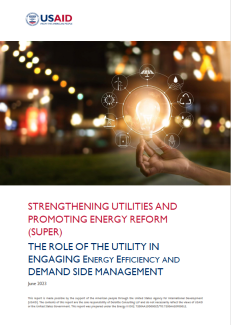The Role of the Utility in Engaging Energy Efficiency and Demand Side Management
Strengthening Utilities and Promoting Energy Reform
GUIDE –
Utilities have a unique opportunity to expand the scope of EE and demand side management (DSM) by leveraging their central space in global energy systems and creating new revenue streams to promote EE (seen as detracting from the traditional, volumetric utility business model).
This report will explore the landscape of EE through the lens of the United States Agency for International Development’s (USAID) EE building blocks; assess the challenges and barriers to utility participation in EE measures; and recommend how USAID can work with utilities to overcome these challenges and partner to incorporate EE into the utility’s operations. Utility-led EE can help improve utility customers’ relationship with their energy usage, achieve operational efficiencies, and respond to policy and regulatory interventions.
Energy Efficiency Building Blocks
Utility EE involves myriad stakeholders, and utilities need to be cognizant about how each of them impacts the EE landscape. This section describes each stakeholder within the context of USAID’s three building blocks of EE, which are EE standards, market priming and financing, and policy planning. This extant framework provides a useful lens through which to evaluate opportunities and categorize the methods utilities can use to develop their EE and demand response (DR) programs.
Energy Efficiency Standards and Enabling Environments
Governments and policymakers often engage with utilities on EE by evaluating market dynamics, exploring regulatory costs and benefits, and establishing technical and equipment performance standards, codes, and retrofits. Energy service companies (ESCOs) are notable players in financing EE projects. Many of USAID’s partner countries do not have projects of sufficient magnitude to make an ESCO attractive, as large consumers of electricity are the primary customers for ESCOs. The lack of certain other necessary conditions favorable to a successful ESCO, such as local banks and other capital providers with the risk appetite to guarantee repayment to an ESCO, cost-reflective tariffs, and capacity to accurately measure results can also reduce the appeal of ESCOs. However, USAID could support ESCO operations outside of the traditional model, where the utility would provide key account turnkey services such as rebates for retrofits, consumer and industrial sector equipment and market studies, and certifications for highly efficient buildings.
With strict utility contractor auditing for monitoring and evaluation purposes, utility companies and regulators play a key role in propelling energy saving activities and capturing realized socio-economic, business, and operational impacts and benefits. Utilities can play a vital role in the education of consumers on EE, through outreach that communicates the importance of investing in higher efficiency technologies and energy smart behaviors which align with environmental stewardship and corporate social responsibility initiatives.
Market Priming and Financing
Utilities can increase operational efficiencies to enhance the scope of EE activities. Through bulk procurement from manufacturers, incentive programs, efficiency funds, and low-income and small business programs, EE financing from financial institutions focuses on deployment of high-efficiency technologies by facilitating reduced costs to consumers and creating economies of scale. Through EE, utilities can initiate and encourage energy efficient habits across consumers through transparent price signals that reduce peak demand or prevent localized outages. As consumer energy demand increases, governments and utilities should educate consumers about the benefits of EE measures, including the individual and social valuation, as an underlying action to complement other efforts.
Policy and Planning
By integrating EE into national power plans, governments can hone in on specific energy targets and strategies to support low emissions development strategies and implementation of climate plans. Policy makers and regulators draft Nationally Determined Contributions (NDCs), which represent a nation’s climate action plan to cut emissions, and many have adopted national plans for EE as well. Utilities can review these types of plans to better understand their role in the EE landscape. These policies can inform shared energy savings targets, or help utilities work with regulators to approve tariffs that will facilitate EE investments.
Challenges and Barriers to Utility Support of Energy Efficiency
The traditional dollars per kWh (kilowatt hour) business model incentivizes most utilities to sell as much electricity as they are able to, providing little encouragement to reduce the amount of electricity sold. Economic barriers to EE include the socioeconomic status of consumers, high capital costs of new technologies, or long payback periods for EE investment. Policymakers and regulators can play a key role in helping utilities promote and deploy EE through setting policies and developing approaches to “decouple” utility business models – break the link between the amount of energy a utility sells (total kWh) and the revenue it collects to recover costs of providing service to customers. Utility engagement in the U.S. has been the most successful in areas where regulators have made EE investments revenue neutral or revenue positive for utilities. Other institutional barriers may include the prevailing norms related to EE or the training levels of professionals in the industry; these can potentially be addressed through appropriate policy and regulation as well.
Investing in customer-driven EE management may appear counterintuitive to the traditional business model, but there are cases where utilities may be interested in implementing EE programs for their own benefit. For example, EE can be an effective tool to reduce peak demand, the point at which demand for electricity is at its highest. Legacy fuel power plants are designed to meet peak demand, but power systems often experience this during less than one percent of the year. A typical power system therefore operates at less than full capacity for 99 percent of the year, which is inefficient. Additionally, in some power markets utilities meet peak demand through generation from natural gas- or oil-fired combustion turbines. These technologies have high variable operation and maintenance costs and may be reliant on imported fuel. EE can also allow for renewable energy (RE) uptake and the avoidance of constructing new, large power plants to meet rising levels of peak demand, leading to increased system efficiency. Additionally, the more a utility is able to offer EE as a service and unlock new revenue streams, the more willing it will be to develop and implement EE programs.
The simple lack of awareness among customers presents a hurdle as well. Utilities have the means to educate their customers, but the way that utilities convey messages differs based on local norms and context. For example, some customers might be more appreciative of EE initiatives that save them money while others might be more receptive to an environmental-oriented message.Feedback mechanisms, and some technologies like in-home displays, can help customers understand the importance of EE and how it benefits them, and build trust with their utility.
Creating an Active Space for Utility-Driven Energy Efficiency
This section details preliminary ideas for making EE a sustainable way for utilities to contribute to the energy transition through the lenses of enhancing consumer relationships with their own electricity usage, achieving operational efficiencies, and aligning with policy decisions. The scale and ease of implementing specific EE schemes will vary by country and by initiative.
Enhancing Customer Relationships
Utilities can educate customers on the benefits of EE and encourage them to think more critically about their energy usage. Utilities can capitalize on this increased awareness by providing financial incentives for EE uptake.
- Improving the consumer experience through digitalization. In-home displays or mobile apps are a way for customers to interact daily with their electricity and note their consumption patterns. Utilities intent on promoting EE should not underestimate the power of such devices. A study of a housing development in the Netherlands found that homes with an electric meter installed in the front hall consumed 30 percent less electricity than homes with an electric meter installed in the basement. The World Resources Institute highlights several studies in India where behavioral programs using direct and indirect feedback (including home energy reports and smart meters) achieved 5 percent to 20 percent energy savings through adjusting consumer habits.
- Established utilities interested in adopting “next generation” technology can look to smart grid and advanced metering infrastructure (AMI) to derive data-driven insights and the efficiencies that these technologies enable, and to help identify value streams in the short-term that justify these longer-term investments. Furnishing customers with this technology allows them to own their relationship with their energy and provides them with enhanced opportunities to recognize areas where they can cut down on usage, either for financial reasons or climate-oriented motivation. In-home displays as described earlier and other features like phone apps further enhance this relationship. AMI technology can also facilitate broader energy transition initiatives, such as monitoring trends in rooftop solar deployment or detecting electric vehicles to provide energy and support services to the local grid.
- Utilities can educate customers through mediums such as email blasts or product labeling, to help them understand topics like how their energy use translates to the amounts on their bills, what time-of-use tariffs are and if they are a good fit with specific behavioral consumption, and, overall, how they can benefit from EE.
- Utilities can reduce peak demand and flatten load growth by providing rebates and incentive programs for EE. Utilities can provide incentives through initiatives such as energy audits or rebates for efficient lighting, HVAC systems, solar water heaters or other RE technologies, and pass the costs along to consumers through bundled rates. The Jamaica Public Service Company (JPS) is one such utility that has utilized such programs. JPS created a text message initiative which utilizes its smart meters to understand consumer energy usage and texts consumers to encourage energy efficient behaviors.
Achieving Operational Efficiencies
EE also provides avenues for utilities to save money, plan for the future of the grid, and begin to incorporate the next generation technologies necessary to the energy transition.
- Demand response (DR) programs allow utilities to shift electricity demand by empowering customers to shift electricity consumption away from peak periods by using time-based rates or other financial incentives
- Utilities may also be interested in promoting EE because it is often the least expensive way of “sourcing” new electricity – its levelized cost of energy (LCOE) is an estimated $.02 - $.04/kWh, whereas natural gas has an LCOE of $.05 - $.08/kWh and utility-scale solar has an LCOE of $.03 - $.04/kWh.10 11 EE can also be a route to closing the gap between subsidized tariffs and the real cost of power. Many governments in developing countries underprice power in favor of garnering good political will and maintaining socio-economic stability. EE measures allow a utility to improve its financial position without sacrificing power supply quality.
- Utilities have access to finance and the ability to distribute resources at scale, making bulk procurement an attractive option for reducing customer energy consumption. Bulk procurement involves a utility’s purchase and distribution of energy efficient appliances – such as lightbulbs – to reduce the amount of power they need to generate and save customers money. India’s Affordable LEDs for All Program purchased LED bulbs and distributed them to customers at an affordable price resulting in annual cost savings for consumers of $2.59 billion and energy savings of 47 billion kWh in 2021. Mexico’s Ahórrate una Luz program promoted the adoption of compact fluorescent lights (CFLs) to replace incandescent bulbs. The program gave five free CFLs to each household in local.ities with fewer than 100,000 inhabitants. In three years, this program replaced approximately 39.8 million incandescent bulbs with CFLs and yielded savings of more than $1 million in government subsidies and family expenditures.
- Advanced technology that is part of EE infrastructure like smart meters can reduce non-technical losses by using advanced analytics to analyze electricity theft from illegal connections, meter tampering, or billing irregularities. Technical losses also decrease as a result of EE initiatives due to the reductions in system peak load, current flow, and energy requirements.
Aligning with Policy and Regulatory Imperatives
Utilities cannot and will not be the sole driving force behind EE initiatives. Governments and regulators also have a key role to play in giving utilities a framework and “nudging” in this direction, opening new revenue streams for these critical actors.
- Performance investment mechanisms (PIMs) and shared savings targets allow utilities to share in the benefits and cost savings associated with EE. Some PIMs allow utilities to earn a share of the benefits of investment, and others allow for a rate of return on EE spending (similarly to how they would for investments in traditional infrastructure like distribution infrastructure). Utilities in New York and Rhode Island have used PIMs to support distributed energy resource adoption and utilization such as distributed energy storage. Con Edison has a PIM to avoid greenhouse gas (GHG) emissions with electric vehicles and heat pumps. Hawaii has implemented a shared savings mechanism to support the procurement of both solar and storage solutions from vendors.
- Decoupling involves regulation that separates a utility’s cost recovery from volume sales. Under a decoupled system, the utility works with the regulator to establish a fixed rate of return. When a utility is not decoupled, their incentive is to sell as much electricity as possible to maximize revenues. When a utility is decoupled from volume sales, they can focus explicitly on providing the best customer service regardless of how much power they sell. This encourages investment in EE, as opposed to a model based on volumetric sales, which disincentivizes EE.
- EE resource planning, through an integrated resource and resilience plan (IRRP) or more general “road map” can, in the medium- to long-term, identify how EE can fit into the broader electricity landscape. This exercise can allow utilities to see how the savings from EE will benefit them through lower peak demand, avoided costs from constructing new infrastructure, or savings obtained from deferred maintenance or other infrastructure expenses. Resource planning initiatives can also establish a link between EE and RE integration. Variable RE resources such as wind and solar have many benefits, but one drawback is that they are intermittent – unlike coal or natural gas they are not always online. EE can facilitate RE uptake by balancing the relationship between demand and the availability of RE. Peak shaving, time-of-use tariff pricing, a lower level of overall demand, and EE technologies such as smart meters and battery energy storage systems can enable these benefits.
- Utilities can propose surcharges on tariffs to fund EE efforts (or RE integration efforts, or assistance to low-income or disadvantaged consumers), especially if this would help comply with GHG reduction targets. Utilities could present such tariffs to regulators as alternative mechanisms to achieve policy goals and/or meet key performance indicators like reliability, improving operational efficiency, or reskilling labor. Tariff designs can include performance-based incentives, such as shared savings opportunities to open new revenue streams to utilities. This is a complex endeavor between utility, regulator, and government but in the long-term can help satisfy the goals of all three. Additionally, many countries already struggle to adopt cost-reflective tariffs due to political and economic considerations and ratepayer resistance, so this strategy may not be relevant in certain countries.
Conclusions and Next Steps
USAID can continue to support electric utilities and the energy transition by exploring the constraints to EE uptake and implementing potential solutions. This further exploration would include an analysis of the features that a power sector model conducive to EE includes, taking into account the technical and operational status of each utility and local grid. Upon the completion of this analysis and the potential launch of pilot programs, electric utilities, USAID staff, implementing partners, and other EE stakeholders can leverage this knowledge to increase their understanding of how to support utilities’ incorporation of EE into their operations, to strategically enhance their energy transition and/or decarbonization goals alongside commercialization priorities.
USAID can support utility decision-making that incorporates EE options compatible with various stages of grid modernization by delivering “EE in a Box,” a playbook that increases awareness of EE and contains a resource package for interested utilities. EE in a Box would contain options for building a business case for EE, communicating with and empowering customers to take advantage of EE to better own their relationship with electricity, and presenting materials about financial mechanisms to help utilities understand what other tools and strategies are at their disposal.
USAID can work with utilities on a more personal basis by facilitating a workshop focused on building the business case for EE. USAID can make the business case to targeted utilities through the facilitation of an EE ecosystem workshop with utility participants and, ideally, their associated regulators and energy ministries
Finally, USAID can foster behavior change at scale by supporting targeted utilities through a technical support pilot program for utility EE. USAID can work with interested utilities to build upon EE in a Box and other materials and gain buy-in from key stakeholders to implement a pilot EE program.




